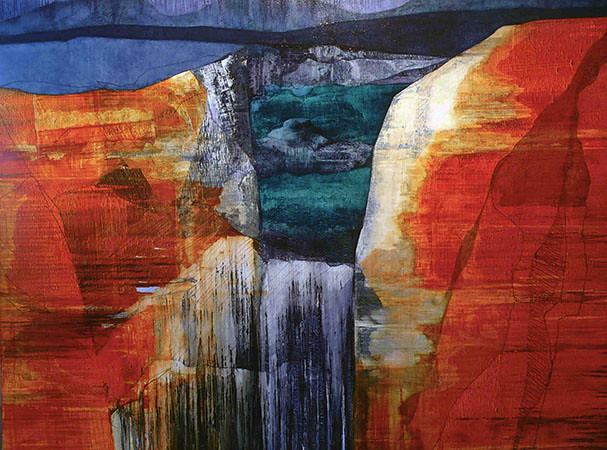11 October - 5 November 2013, Glass Tank, Oxford Brookes University
With drawings and paintings by Zoe Benbow (Associate Lecturer in Fine Art at Oxford Brookes in 2010-11) and poetry selected by Deryn Rees-Jones, poet and academic (shortlisted for the T.S. Eliot Prize, 2012 and Welsh Book of the Year, 2013 for Burying the Wren).

Water, sky, earth, coast. No landscape exists out of context: like anything else landscape is as subject to the effects of time, culture, power, ownership and ecology as it is to its poetical, historical and gendered constructions. Zoe Benbow’s pictures, made in situ, as she engages with, and places herself in the reality of the landscape – its weather, and the shifting light which makes impressions on the contours she temporarily inhabits rather than simply regards – evoke what she has described as ‘an abstract geological landscape developed from direct experience in remote environments’. The move towards abstraction for Benbow is also a movement between conscious and unconscious worlds and she has described her method as being ‘as much a meditation on a geology of association and memory as of actual place’.
Set here in lively conversation with a range of poems by British and American women chosen by poet Deryn Rees-Jones, important questions are asked in the ensuing dialogue about the relationship between, and the construction of, the female self and the natural world. Although the poems are largely written by Benbow’s contemporaries, by way of context they are framed by the work of three important poetic predecessors: Charlotte Smith (1749-1806), Emily Dickinson (1830-1886) and Sylvia Plath (1932-1963). As in Benbow’s work, all the poems, in their differing ways, address ideas of scale and perspective, the relationship between the micro and the macrocosmic, and the process of looking itself. The cumulative effect asks that we readjust the focus of our eyes, and in doing so also find new focus in our imagination.
You can read more about Zoe’s work on her website, and more about Deryn’s poetry and research on her page at the University of Liverpool.
To tie in with this exhibition, the Poetry Centre hosted writing and painting workshops with Sarah Corbett (whose poetry featured in the exhibition) and Zoe Benbow. It also organized a reading by Sarah Corbett and Deryn Rees-Jones, and a panel discussion about the exhibition with Zoe, Sarah, Deryn and the Director of the Poetry Society, Judith Palmer. Where We Begin to Look first appeared at the Poetry Society’s Poetry Cafe in London in 2013, and the Society sponsored the touring exhibition, which also visited Organic House, Hebden Bridge, and the Norwich Arts Centre.

